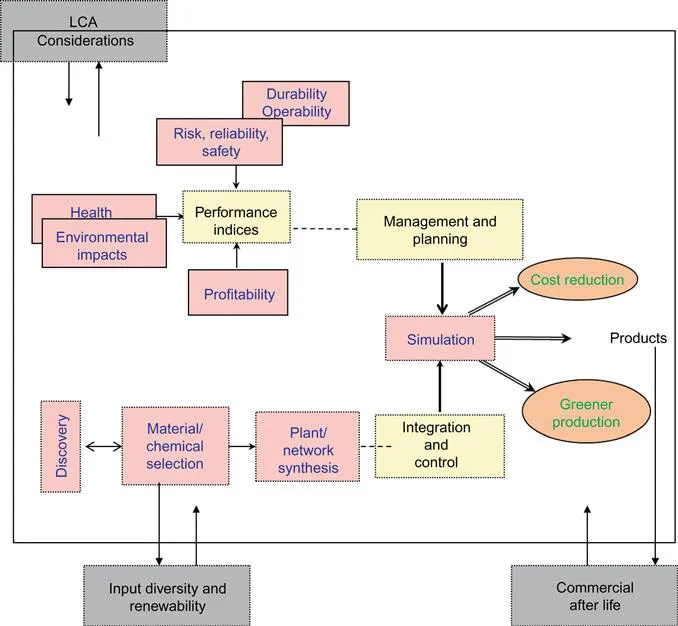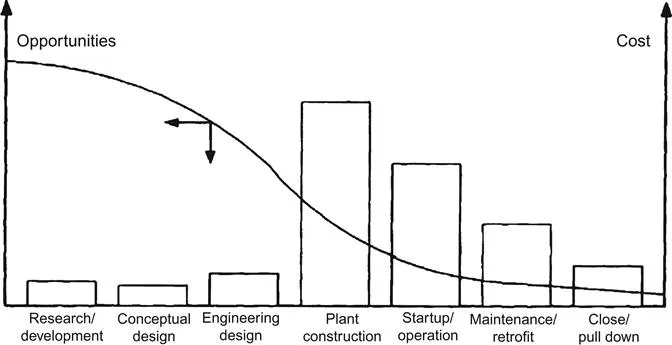
eBook - ePub
Assessing and Measuring Environmental Impact and Sustainability
- 608 pages
- English
- ePUB (mobile friendly)
- Available on iOS & Android
eBook - ePub
Assessing and Measuring Environmental Impact and Sustainability
About this book
Assessing and Measuring Environmental Impact and Sustainability answers the question "what are the available methodologies to assess the environmental sustainability of a product, system or process? Multiple well-known authors share their expertise in order to give a broad perspective of this issue from a chemical and environmental engineering perspective. This mathematical, quantitative book includes many case studies to assist with the practical application of environmental and sustainability methods. Readers learn how to efficiently assess and use these methods.
This book summarizes all relevant environmental methodologies to assess the sustainability of a product and tools, in order to develop more green products or processes. With life cycle assessment as its main methodology, this book speaks to engineers interested in environmental impact and sustainability.
- Helps engineers to assess, evaluate, and measure sustainability in industry
- Provides workable approaches to environmental and sustainability assessment
- Readers learn tools to assess the sustainability of a process or product and to design it in an environmentally friendly way
Frequently asked questions
Yes, you can cancel anytime from the Subscription tab in your account settings on the Perlego website. Your subscription will stay active until the end of your current billing period. Learn how to cancel your subscription.
At the moment all of our mobile-responsive ePub books are available to download via the app. Most of our PDFs are also available to download and we're working on making the final remaining ones downloadable now. Learn more here.
Perlego offers two plans: Essential and Complete
- Essential is ideal for learners and professionals who enjoy exploring a wide range of subjects. Access the Essential Library with 800,000+ trusted titles and best-sellers across business, personal growth, and the humanities. Includes unlimited reading time and Standard Read Aloud voice.
- Complete: Perfect for advanced learners and researchers needing full, unrestricted access. Unlock 1.4M+ books across hundreds of subjects, including academic and specialized titles. The Complete Plan also includes advanced features like Premium Read Aloud and Research Assistant.
We are an online textbook subscription service, where you can get access to an entire online library for less than the price of a single book per month. With over 1 million books across 1000+ topics, we’ve got you covered! Learn more here.
Look out for the read-aloud symbol on your next book to see if you can listen to it. The read-aloud tool reads text aloud for you, highlighting the text as it is being read. You can pause it, speed it up and slow it down. Learn more here.
Yes! You can use the Perlego app on both iOS or Android devices to read anytime, anywhere — even offline. Perfect for commutes or when you’re on the go.
Please note we cannot support devices running on iOS 13 and Android 7 or earlier. Learn more about using the app.
Please note we cannot support devices running on iOS 13 and Android 7 or earlier. Learn more about using the app.
Yes, you can access Assessing and Measuring Environmental Impact and Sustainability by Jiri J Klemes,Jiří Jaromír Klemeš in PDF and/or ePUB format, as well as other popular books in Technology & Engineering & Environmental Science. We have over one million books available in our catalogue for you to explore.
Information
Chapter 1
Engineering sustainability
Urmila Diwekar, Vishwamitra Research Institute, Crystal Lake, IL, USA
Sustainability analysis is, by definition, multi-disciplinary. In this chapter, we present engineering sustainability by using various systems analysis approaches from different disciplines. Sustainability starts with green manufacturing and extends to industrial networks and then to the ecosystem. These systems are complex and extend boundaries of current analysis frameworks. Uncertainties exist at every stage of analysis, and dealing with uncertainty in a systematic way is necessary. Analysis approaches from optimization, social science, and financial literature are used to solve problems related to sustainability.
Keywords
Sustainability; industrial ecology; green design; uncertainty; stochastic optimal control; forecasting; Ito processes
Introduction
The most widely accepted definition of sustainability or sustainable development is attributed to the World Commission on Environment and Development (1987). The Commission stated in its final report that “Sustainable development is development that meets the needs of the present without compromising the ability of future generations to meet their own needs.” This definition clearly defines sustainability on a larger timescale by alluding to the future (Cabezas, 2013). Engineers are good at decision making when they can model the phenomenon correctly. However, sustainability that starts with green manufacturing involves beginning decision making at early stages of design and considering objectives that are not well quantified. This involves multi-criteria decision making in the face of uncertainties. Industrial ecology deals with complex industrial networks and dynamic decision making. Sustainability goes beyond industrial ecology when the system boundaries extend to our planet and long-term impacts need to be considered. Dynamic decision making and adaptive management are needed to address the complete problem of sustainability. Systems analysis approaches can provide tools for addressing these problems. However, there are challenges in applying current approaches to sustainable system analysis. Forecasting is an important part of decision making because sustainability is important for the future. Given that the future brings many uncertainties, addressing these uncertainties in both quantitative and qualitative forms is important in decision making. These uncertainties could be static or dynamic. It should be remembered that sustainability is a path, and sustainable decision making involves finding this path through time. There are no absolutes in sustainability; it is always relative (Sikdar, 2014). We present the problem of sustainability, starting with sustainable manufacturing as extending boundaries of traditional decision making, followed by systems analysis approaches and challenges to solve this problem.
Extending boundaries
The Burndland commission definition (World Commission on Environment and Development, 1987) of sustainability originated from the concerns that the current trends in population and economic developments are not sustainable. Coupled with adverse environmental impacts like global climate change, degradation of air, water, and land, depletion of natural resources, including freshwater minerals, loss of agricultural land because of deforestation, soil erosion, and urbanization are threatening the ecosystem (Bakshi and Fiksel, 2003). To make the planet sustainable, the efforts should be made at all levels of ecosystem. At the industrial level, green engineering means green processes, green products, green energy, and eco-friendly management by considering environmental and other societal impacts as objectives and not constraints used in traditional design. Figure 1.1 shows the integrated framework recently developed (Diwekar, 2003) to include the green engineering principles at all stages. Unlike the traditional process design in which engineers are looking for low-cost options, environmental considerations include various objectives like the long-term and short-term environmental impacts. This framework includes decisions at all levels, starting from the chemical or material selection and the process synthesis stages, to the management and planning stage, which is linked to green objectives and goals (top left corner of the Figure 1.1). It is important to start as early as possible in the design process to enhance the impact of waste minimization (Figure 1.2) (Yang and Shi, 2000).


It should be remembered that as we extend the traditional boundaries of process and plant design to include early decisions like material selections, the models and data available for the analysis are fraught with uncertainties. Therefore, to address sustainability at the plant level, we need to use multi-objective methods in the face of uncertainties.
Life cycle considerations and commercial afterlife are also included in this decision making. They are shown beyond the boundaries of the framework, because life cycle analysis and afterlife analysis involve extending the boundary of the design further. Obviously, uncertainties increase as we extend the framework.
This framework shows that the first step toward green engineering is to extend the traditional boundaries of design. Because sustainability is a property of the entire system, it requires boundaries of the design to be greatly expanded beyond green design, green products, and green management to industrial ecology and to the ecosystem of the entire planet (Figure 1.3) (Diwekar and Shastri, 2010).

The next step toward sustainability in Figure 1.3 is industrial ecology. Industrial ecology is the study of the flows of materials and energy in industrial and consumer activities, of the effects of these flows on the environment, and of the influences of economic, political, regulatory, and social factors on the use, transformation, and disposition of resources (White, 1994). Industrial ecology applies the principles of material and energy balance traditionally used by scientists and engineers to analyze well-defined ecological systems or industrial unit operations to more complex systems involving natural and human interaction. These systems can involve activities and resource utilization over scales ranging from single industrial plants to entire sectors, regions, or economies. In so doing, the laws of conservation must consider a wide range of interacting economic, social, and environmental indicators. Figure 1.4 presents a conceptual framework for industrial ecology applied at different scales of spatial and economic organization evaluating alternative management options using different types of information, tools for analysis, and criteria for performance evaluation. As one moves from the small scale of a single-unit operation or industrial production plant to the larger scales of an integrated industrial park, community, firm, or sector, the available management options expand from simple changes in process operation and inputs to more complex resource management strategies, including integrated waste recycling and reuse options. The information changes from quantitative to order of magnitude to qualitative, and uncertainties increase. Special focus has been placed on implementing the latter via industrial symbiosis, for example, through the pioneering work of integrating several industrial and municipal facilities in Kalundborg, Denmark (Ehrenfeld and Gertler, 1997). Business case of sustainability (Beloff, 2013) often describes the triple bottom line approach, namely, economic performance, environmental performance, and social performance of industry. However, industrial ecology advocates going beyond this triple bottom line. Industrial networks comprise any number of organizations that are linked to each other through the exchange of resources. A systems approach is a necessary prerequisite to understanding interaction between organizations and its consequences for the socio-economic and biophysical ...
Table of contents
- Cover image
- Title page
- Table of Contents
- Copyright
- Contributors
- Preface
- Acknowledgments
- Introduction
- Chapter 1. Engineering sustainability
- Chapter 2. Recent developments in the application of Fisher information to sustainable environmental management
- Chapter 3. Sustainable process index
- Chapter 4. Moving to a decision point in sustainability analyses
- Chapter 5. Overview of environmental footprints
- Chapter 6. N footprint and the nexus between C and N footprints
- Chapter 7. The water footprint of industry
- Chapter 8. Life cycle sustainability aspects of microalgal biofuels
- Chapter 9. Methods and tools for sustainable chemical process design
- Chapter 10. Life cycle assessment as a comparative analysis tool for sustainable brownfield redevelopment projects: Cumulative energy demand and greenhouse gas emissions
- Chapter 11. The Environmental Performance Strategy Map: An integrated life cycle assessment approach to support the strategic decision-making process
- Chapter 12. Green supply chain toward sustainable industry development
- Chapter 13. Supply and demand planning and management tools toward low carbon emissions
- Chapter 14. Setting a policy for sustainability: The importance of measurement
- Chapter 15. Sustainability assessments of buildings, communities, and cities
- Index